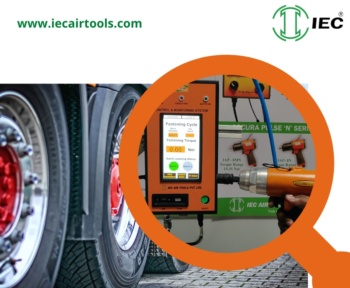The Indian industrial fasteners market is expected to reach INR 460 billion by 2023, growing at a 9.6% CAGR from 2018.
Let us start by defining what pneumatic tools are. A pneumatic tool is a tool that runs on compressed air rather than electricity. An air compressor used with a pneumatic tool delivers air volume and pressure in cubic feet per minute (CFM) and pounds per square inch (PSI).
The Benefits of Pneumatic Tools
When compared to electric tools, pneumatic tools are lightweight, safer, and easier to handle.
- With fanned and variable speed choices, pneumatic tools are reliable and user-friendly.
- They enable high precision and accurate positioning.
- They can be employed for a wide range of industrial applications.
- There is little need for batteries or an external power source.
- Pneumatic tools can be used in any environment, in wet conditions, in mines, and around flammable materials.
Today, we have come a long way from the hand bellows that were used by blacksmiths and smelters to work on metals in the old days. That was considered to be the first compressor and the first pneumatic tool of its kind. The pneumatic tool market grew with the introduction of automation, automatic machines and control systems. It was in the 1960s that the market grew exponentially when a new segment of digital-logic pneumatic-control components were developed for use in different power and control systems. Pneumatics as an industry continues to grow and advance today, with leading manufacturers offering components and tools with that little bit more functionality, efficiency, performance, and reliability.
Types of Pneumatic Tools
The pneumatic tool list and applications are diverse and exhaustive. Here we highlight a few of the many pneumatic tools available.
The Air Impact Wrench
The rotating mass or hammer of an air impact wrench stores energy for delivery to an output shaft.
Air screwdrivers (shut-off type, with slip clutch, and impact type)
These pneumatic screwdrivers turn screws with tight control of the screw torque using an automated process.
Air Ratchet Wrenches
Among many other tools for tightening and loosening bolts, the pneumatic ratchet torque wrench is very popular. Manufacturers of heavy industry, construction, automobiles, and aerospace use them extensively.
Air Tappers
In the automotive and machine-building industries, pneumatic tappers are ideal for tapping threads as well as cleaning threads in materials like steel, aluminum, and other alloys.
Pneumatic drill machines, grinders, and sanders
An abrasive is bonded to a wheel, belt, or disc on a pneumatic grinder or sander to remove material and improve the surface finish or chamfer of a particular part.
Oil Pulse Tools
Oil pulse tools have always been known for their ergonomic qualities and high run-down speeds. The oil pulse unit replaces the hammer mechanism for smoother, softer, and more stable “impulsing,” which results in less vibration, lower noise, and less user fatigue.
Shut-off and non-shut-off type pneumatic oil pulse tools.
It is preferable to use an auto-shut-off tool if the aim is to minimise operator influence. By setting the torque within the range of the tool, the tool will shut off upon achieving the predetermined torque by cutting off the air supply to the motor. This results in higher accuracy.
Pneumatic transducerised oil pulse tools with controllers
A pneumatic transducer-powered oil pulse tool with a controller provides torque feedback and shut-off with closed-loop control. The torque data is stamped and enables traceability. This is an efficient poka-yoke tool that allows complete control of fastening procedures.
The Indian Pneumatic Fastener Scenario
There are several sorts of fasteners, each serving a specific purpose.
Fasteners are mechanical devices that mechanically link two or more items together, either permanently or temporarily. There are several sorts of fasteners, each serving a specific purpose.
Fasteners are classified as either permanent or temporary. Permanent fasteners, such as rivets and nails, are single-use fasteners used to permanently link two materials or pieces.
Due to their application in various sectors, a wider array of fasteners are manufactured in the Indian market. Research reports show that the Indian industrial fasteners market is expected to reach INR 460 billion by 2023, growing at a 9.6% CAGR from 2018.
Despite its growth, this market is highly fragmented, with manufacturers and suppliers of application- or product-specific pneumatic tools based in South, Western, and Northern India.The cluster of industrial centres aims to provide faster delivery to end markets. Pneumatic tool manufacturers in India often market their goods via a variety of distribution channels, including distributors, direct dealers, internet platforms, and industrial events.
The fasteners market in India is divided into three sections: application, product type, and market organization. By 2023, the Indian automotive industry is predicted to be the largest user of industrial fasteners, accounting for a significant part of the market. This will be due to an expansion in auto manufacturing in India.
Globally, the COVID-19 epidemic has brought economic distress and upheaval. No country has been spared the virus and its economic ramifications.
A huge slump in construction activity was experienced in 2020, especially during Q1 and Q2 of 2020. which halted all infrastructure activities. Studies show that by 2022, India is expected to contribute $635 billion to the global construction market, which means growth can be more predictable post-2021.
Construction projects in India will continue to grow in the next few years, which will also increase the demand for industrial fasteners.
Together with its aerospace, construction, and automobile manufacturing industries, India is on a steady development trajectory. As a consequence, the fastener industry in India appears to be promising for tool suppliers. Because the market potential for innovative manufacturing has been significantly increasing in recent years, India is expected to provide numerous prospects for both global and local pneumatic tool suppliers throughout the projected period.









